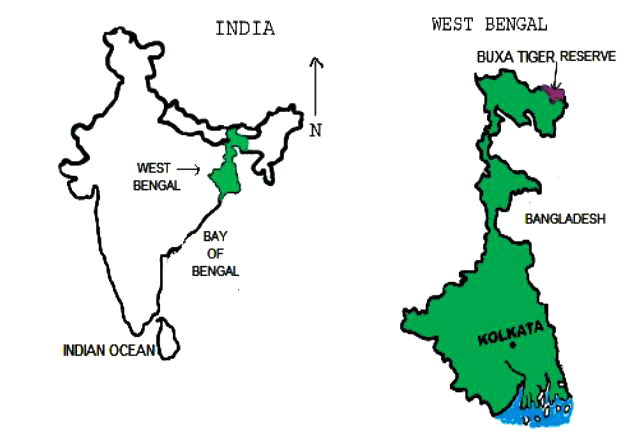BUXA TIGER RESERVE FOREST
Buxa Tiger Reserve is situated in the Alipurduar Sub-division of Jalpaiguri District, West Bengal. It was created in 1983 as the 15th tiger reserve of India.It was declared as a National Park in January 1992.Buxa Tiger Reserve is a Tiger reserve and National park in northern West Bengal, India, which is covering an area of 760 km2 (290 sq mi). In altitude, it ranges from 60 m (200 ft) in the Gangetic Plains to 1,750 m (5,740 ft) bordering the Himalayas in the north. At least 284 bird species inhabit the reserve. it is home of Mammals present include Asian elephant, gaur, Sambar deer, clouded leopard, Indian leopard.
History
Buxa Tiger Reserve
The historic Buxa Fort (2,600 feet or 790 metres above m.s.l.). People have sentimental attachment with the fort on accounts of its association with the struggle for freedom.Buxa Tiger Reserve was created in 1983 as the 15th tiger reserve in India. In 1986, Buxa Wildlife Sanctuary was constituted over 314.52 km2 of the reserve forests. In 1991, 54.47 km2 was added to Buxa Wildlife Sanctuary. A year later, in 1992, the Government of West Bengal declared its intentions to constitute a national park over 117.10 km2 of the Buxa Wildlife Sanctuary.
location:
Buxa Tiger Reserve lies in Alipurduar district of West Bengal.
Its northern boundary runs along the international border with Bhutan.
The Sinchula hill range lies all along the northern side of BTR and the eastern boundary touches that of the Assam state.
National Highway No.31 C roughly runs along its southern boundary. It is the easternmost extension of extreme bio-diverse North-East India and represents highly endemic Indo-Malayan region.
The fragile "Terai Eco-System" constitutes a part of this reserve. The Phibsoo Wildlife Sanctuary of Bhutan is contiguous to the north of BTR. Manas National Park lies on east of BTR. BTR, thus, serves as international corridor for Asian elephant migration between India and Bhutan. To the south-west, the Chilapata Forests form an elephant corridor to the Jaldapara Wildlife Sanctuary.
The reserve encompasses as many as eight forest types. The divisional headquarters is located at Alipurduar. The forest is divided into two divisions: East and West. Buxa Fort is an important landmark for this reserve. This fort was captured by British-India in 1865 after the Bhutan War from Bhutan. Later this fort was used as a detention camp for Indian freedom fighters during the Indian freedom movement.
Flora
More than 450 species of trees, 250 species of shrubs, 400 species of herbs, 9 species of cane, 10 species of bamboo, 150 species of orchids, 100 species of grass and 130 species of aquatic flora including more than 70 sedges (Cyperaceae) have been identified so far. There are more than 160 species of other monocotyledons and ferns. The main trees are sal, champa, gamhar, simul and chikrasi
Fauna
During a survey in May 2000 to July 2001, 284 bird species were recorded including Eurasian griffon (Gyps fulvus), Amur falcon (Falco amurensis), Malayan night heron (Gorsachius melanolophus), Oriental pied hornbill (Anthracoceros albirostris), rufous-necked hornbill (Aceros nipalensis), chestnut-breasted partridge (Arborophila mandellii), cinnamon bittern (Ixobrychus cinnamomeus), stripe-breasted woodpecker (Dendrocopos atratus), velvet-fronted nuthatch (Sitta frontalis) and black-naped oriole (Oriolus chinensis).The Narathali lake, Raidāk and Jayanti rivers provide habitat to migratory birds like common merganser (Mergus merganser), Eurasian teal (Anas crecca), black-necked crane (Grus nigricollis), black stork (Ciconia nigra), and ferruginous pochard (Aythya nyroca). Two new frog species were discovered in 2006
The 73 mammal species include Indian leopard, Bengal tiger, clouded leopard, giant squirrel, gaur, chital and wild boar. 65 fish, 41 reptile and four amphibian species have been identified In February 2018, golden and spotted Asiatic golden cats (Catopuma temminckii) were recorded in the reserve for the first time.
Endangered species present in the reserve are leopard cat, Bengal florican, reticulated python, Chinese pangolin, hispid hare,hog deer lesser adjutant (Leptoptilos javanicus), white-rumped vulture (Gyps bengalensis), slender-billed vulture (Gyps tenuirostris), chestnut-breasted partridge (Arborophila mandellii), rufous necked hornbill (Aceros nipalensis), ferruginous pochard (Aythya nyroca) and great hornbill (Buceros bicornis)
source: wikipedia






.jpeg)








0 Comments